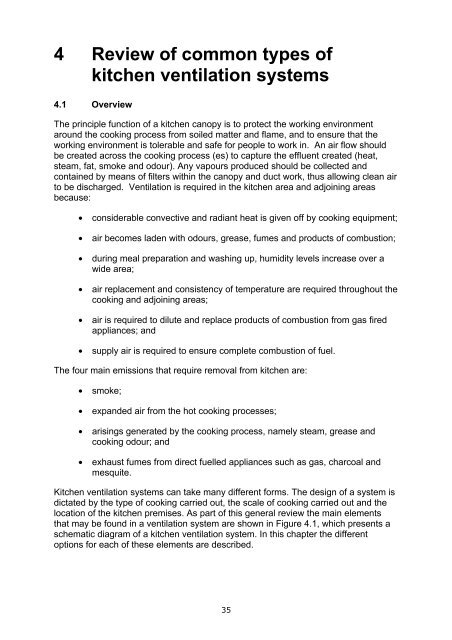Guidance on the Control of Odour and Noise from ... - Defra
Guidance on the Control of Odour and Noise from ... - Defra
Guidance on the Control of Odour and Noise from ... - Defra
You also want an ePaper? Increase the reach of your titles
YUMPU automatically turns print PDFs into web optimized ePapers that Google loves.
4 Review <strong>of</strong> comm<strong>on</strong> types <strong>of</strong><br />
kitchen ventilati<strong>on</strong> systems<br />
4.1 Overview<br />
The principle functi<strong>on</strong> <strong>of</strong> a kitchen canopy is to protect <strong>the</strong> working envir<strong>on</strong>ment<br />
around <strong>the</strong> cooking process <strong>from</strong> soiled matter <strong>and</strong> flame, <strong>and</strong> to ensure that <strong>the</strong><br />
working envir<strong>on</strong>ment is tolerable <strong>and</strong> safe for people to work in. An air flow should<br />
be created across <strong>the</strong> cooking process (es) to capture <strong>the</strong> effluent created (heat,<br />
steam, fat, smoke <strong>and</strong> odour). Any vapours produced should be collected <strong>and</strong><br />
c<strong>on</strong>tained by means <strong>of</strong> filters within <strong>the</strong> canopy <strong>and</strong> duct work, thus allowing clean air<br />
to be discharged. Ventilati<strong>on</strong> is required in <strong>the</strong> kitchen area <strong>and</strong> adjoining areas<br />
because:<br />
• c<strong>on</strong>siderable c<strong>on</strong>vective <strong>and</strong> radiant heat is given <strong>of</strong>f by cooking equipment;<br />
• air becomes laden with odours, grease, fumes <strong>and</strong> products <strong>of</strong> combusti<strong>on</strong>;<br />
• during meal preparati<strong>on</strong> <strong>and</strong> washing up, humidity levels increase over a<br />
wide area;<br />
• air replacement <strong>and</strong> c<strong>on</strong>sistency <strong>of</strong> temperature are required throughout <strong>the</strong><br />
cooking <strong>and</strong> adjoining areas;<br />
• air is required to dilute <strong>and</strong> replace products <strong>of</strong> combusti<strong>on</strong> <strong>from</strong> gas fired<br />
appliances; <strong>and</strong><br />
• supply air is required to ensure complete combusti<strong>on</strong> <strong>of</strong> fuel.<br />
The four main emissi<strong>on</strong>s that require removal <strong>from</strong> kitchen are:<br />
• smoke;<br />
• exp<strong>and</strong>ed air <strong>from</strong> <strong>the</strong> hot cooking processes;<br />
• arisings generated by <strong>the</strong> cooking process, namely steam, grease <strong>and</strong><br />
cooking odour; <strong>and</strong><br />
• exhaust fumes <strong>from</strong> direct fuelled appliances such as gas, charcoal <strong>and</strong><br />
mesquite.<br />
Kitchen ventilati<strong>on</strong> systems can take many different forms. The design <strong>of</strong> a system is<br />
dictated by <strong>the</strong> type <strong>of</strong> cooking carried out, <strong>the</strong> scale <strong>of</strong> cooking carried out <strong>and</strong> <strong>the</strong><br />
locati<strong>on</strong> <strong>of</strong> <strong>the</strong> kitchen premises. As part <strong>of</strong> this general review <strong>the</strong> main elements<br />
that may be found in a ventilati<strong>on</strong> system are shown in Figure 4.1, which presents a<br />
schematic diagram <strong>of</strong> a kitchen ventilati<strong>on</strong> system. In this chapter <strong>the</strong> different<br />
opti<strong>on</strong>s for each <strong>of</strong> <strong>the</strong>se elements are described.<br />
35
















